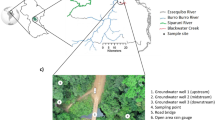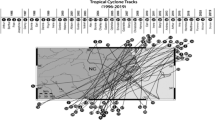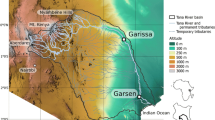Abstract
Two intense rainfalls [Hurricane Joaquin (2015) and Hurricane Matthew (2016)], one year apart, provided a unique opportunity to examine changes in dissolved organic matter (DOM) dynamics in coastal blackwater rivers under extreme flooding conditions in the southeastern United States. Two sites along Waccamaw River (a coastal blackwater river) and the outflow of 18 sub-basins of Yadkin-Pee Dee Basin were sampled during and after the flooding events. The peaks of dissolved organic carbon (DOC) and nitrogen (DON) concentrations were observed 18 and 23 days after peak discharge in 2015 and 2016, respectively. Moreover, DOM aromaticity and abundance of humic substances significantly increased during the same period. Separation of discharge hydrograph into surface runoff and subsurface flow suggested that temporal changes were mainly due to contributions from subsurface flow flushing organic matter from wetlands and organic-rich riparian zones. The spatial analysis highlighted the key role of the forested wetlands as the only land use that significantly correlated with both DOM quantity (DOC and DON load) and DOM composition (i.e., aromaticity). The Yadkin-Pee Dee River basin alone exported more than 474 million kg DOC into the ocean during high-flow conditions from the 2016 event, indicating that such extreme short-term events mobilized enormous amounts of organic carbon and nitrogen to the ocean. Considering the predicted increase in frequency and intensity of extreme rainfall events in the eastern U.S., the results of this study can shed light on changes in DOM dynamics that may occur under such conditions in the near future.









Similar content being viewed by others
References
Austnes K, Evans CD, Eliot-Laize C et al (2010) Effects of storm events on mobilisation and in-stream processing of dissolved organic matter (DOM) in a Welsh peatland catchment. Biogeochemistry 99:157–173. doi:10.1007/s10533-009-9399-4
Avery GB, Kieber RJ, Willey JD et al (2004) Impact of hurricanes on the flux of rainwater and Cape Fear River water dissolved organic carbon to Long Bay, southeastern United States. Glob Biogeochem Cycles. doi:10.1029/2004GB002229
Bender MA, Knutson TR, Tuleya RE et al (2010) Modeled impact of anthropogenic warming on the frequency of intense Atlantic Hurricanes. Science 327:454–458. doi:10.1126/science.1180568
Bradley PM, Journey CA, Chapelle FH et al (2010) Flood hydrology and methylmercury availability in Coastal Plain Rivers. Environ Sci Technol 44:9285–9290. doi:10.1021/es102917j
Chen W, Westerhoff P, Leenheer JA, Booksh K (2003) Fluorescence excitation–emission matrix regional integration to quantify spectra for dissolved organic matter. Environ Sci Technol 37:5701–5710. doi:10.1021/es034354c
Chow AT, Dai J, Conner WH et al (2012) Dissolved organic matter and nutrient dynamics of a coastal freshwater forested wetland in Winyah Bay, South Carolina. Biogeochemistry 112:571–587. doi:10.1007/s10533-012-9750-z
Dhillon GS, Inamdar S (2013) Extreme storms and changes in particulate and dissolved organic carbon in runoff: Entering uncharted waters?: extreme storms and runoff carbon. Geophys Res Lett 40:1322–1327. doi:10.1002/grl.50306
Dillon PJ, Molot LA (1997) Effect of landscape form on export of dissolved organic carbon, iron, and phosphorus from forested stream catchments. Water Resour Res 33:2591–2600. doi:10.1029/97WR01921
Eckhardt BW, Moore TR (1990) Controls on dissolved organic carbon concentrations in streams, Southern Québec. Can J Fish Aquat Sci 47:1537–1544. doi:10.1139/f90-173
Ek MB, Mitchell KE, Lin Y et al (2003) Implementation of Noah land surface model advances in the National Centers for Environmental Prediction operational mesoscale Eta model. J Geophys Res Atmospheres 108:8851. doi:10.1029/2002JD003296
Emanuel K (2005) Increasing destructiveness of tropical cyclones over the past 30 years. Nature 436:686–688. doi:10.1038/nature03906
Feaster TD, Shelton JM, Robbins JC (2015) Preliminary peak stage and streamflow data at selected USGS streamgaging stations for the South Carolina flood of October 2015. U.S. Geological Survey, Reston
Fellman JB, Hood E, Edwards RT, D’Amore DV (2009) Changes in the concentration, biodegradability, and fluorescent properties of dissolved organic matter during stormflows in coastal temperate watersheds. J Geophys Res Biogeosciences 114:G01021. doi:10.1029/2008JG000790
Hinton MJ, Schiff SL, English MC (1997) The significance of storms for the concentration and export of dissolved organic carbon from two Precambrian Shield catchments. Biogeochemistry 36:67–88
Hood E, Gooseff MN, Johnson SL (2006) Changes in the character of stream water dissolved organic carbon during flushing in three small watersheds, Oregon. J Geophys Res Biogeosciences 111:G01007. doi:10.1029/2005JG000082
Hornberger GM, Bencala KE, McKnight DM (1994) Hydrological controls on dissolved organic carbon during snowmelt in the Snake River near Montezuma, Colorado. Biogeochemistry 25:147–165. doi:10.1007/BF00024390
Inamdar SP, Mitchell MJ (2007) Storm event exports of dissolved organic nitrogen (DON) across multiple catchments in a glaciated forested watershed. J Geophys Res Biogeosciences 112:G02014. doi:10.1029/2006JG000309
Inamdar S, Singh S, Dutta S et al (2011) Fluorescence characteristics and sources of dissolved organic matter for stream water during storm events in a forested mid-Atlantic watershed. J Geophys Res Biogeosciences 116:G03043. doi:10.1029/2011JG001735
Jazaei F, Simpson MJ, Clement TP (2014) An analytical framework for quantifying aquifer response time scales associated with transient boundary conditions. J Hydrol 519:1642–1648. doi:10.1016/j.jhydrol.2014.09.018
Jazaei F, Simpson MJ, Clement TP (2016) Spatial analysis of aquifer response times for radial flow processes: nondimensional analysis and laboratory-scale tests. J Hydrol 532:1–8. doi:10.1016/j.jhydrol.2015.11.024
Jazaei F, Simpson MJ, Clement TP (2017) Understanding time scales of diffusive fluxes and the implication for steady state and steady shape conditions. Geophys Res Lett 44:174–180. doi:10.1002/2016GL071914
Karanfil T, Schilutman M, Erdogan I (2002) survey of DOC and UV measurement practices with implications for SUVA determination. J Am Water Works Assoc 94:68–80
Kawasaki M, Ohte N, Kabeya N, Katsuyama M (2008) Hydrological control of dissolved organic carbon dynamics in a forested headwater catchment, Kiryu Experimental Watershed, Japan. Hydrol Process 22:429–442. doi:10.1002/hyp.6615
Krasner S, Sclimenti M, Guo Y et al (2004) Development of DBP and nitrosamine formation potential tests for treated wastewater, reclaimed water, and drinking water. AWWA Denver, CO
Lee W, Westerhoff P (2005) Dissolved organic nitrogen measurement using dialysis pretreatment. Environ Sci Technol 39:879–884. doi:10.1021/es048818y
Lim KJ, Engel BA, Tang Z et al (2005) Automated web GIS based hydrograph analysis tool, WHAT. JAWRA J Am Water Resour Assoc 41:1407–1416
Linkhorst A, Dittmar T, Waska H (2017) Molecular fractionation of dissolved organic matter in a shallow subterranean estuary: the role of the iron curtain. Environ Sci Technol 51:1312–1320. doi:10.1021/acs.est.6b03608
Liu Y, Lewis SAY, Hu L et al (2011) During the Gulf of Mexico and East Coast Carbon cruise. J Geophys Res 116:1–10. doi:10.1029/2010JC006729
Majidzadeh H, Wang J-J, Chow AT (2015) Prescribed fire alters dissolved organic matter and disinfection by-product precursors in forested watersheds—Part I. A controlled laboratory study. In: recent advances in disinfection by-products. American Chemical Society, pp 271–292
Marton JM, Herbert ER, Craft CB (2012) Effects of salinity on denitrification and greenhouse gas production from laboratory-incubated Tidal Forest Soils. Wetlands 32:347–357. doi:10.1007/s13157-012-0270-3
Mei Y, Hornberger GM, Kaplan LA et al (2014) The delivery of dissolved organic carbon from a forested hillslope to a headwater stream in southeastern Pennsylvania, USA. Water Resour Res 50:5774–5796. doi:10.1002/2014WR015635
Ohno T (2002) Fluorescence inner-filtering correction for determining the humification index of dissolved organic matter. Environ Sci Technol 36:742–746. doi:10.1021/es0155276
Orlikowska A, Stolle C (2017) Dynamics of halocarbons in coastal surface waters during short term mesocosm experiments. doi:10.1071/EN14204
Raymond PA, Saiers JE (2010) Event controlled DOC export from forested watersheds. Biogeochemistry 100:197–209. doi:10.1007/s10533-010-9416-7
Runkel R, Crawford, C, Cohn T (2004) USGS Colorado water resources publication—Load Estimator (LOADEST): a FORTRAN program for estimating constituent loads in streams and rivers. In: Techniques and Methods Book 4. U.S. Department of the Interior
Seitzinger SP, Sanders RW, Styles R (2002) Bioavailability of DON from natural and anthropogenic sources to estuarine plankton. Limnol Oceanogr 47:353–366. doi:10.4319/lo.2002.47.2.0353
Sharifi A, Kalin L, Hantush MM et al (2013) Carbon dynamics and export from flooded wetlands: a modeling approach. Ecol Model 263:196–210. doi:10.1016/j.ecolmodel.2013.04.023
Shim MJ, Cai Y, Guo L, Shiller AM (2017) Floodplain effects on the transport of dissolved and colloidal trace elements in the East Pearl River, Mississippi. Hydrol Process 31:1086–1099. doi:10.1002/hyp.11093
Simpson MJ, Jazaei F, Clement TP (2013) How long does it take for aquifer recharge or aquifer discharge processes to reach steady state? J Hydrol 501:241–248. doi:10.1016/j.jhydrol.2013.08.005
Smith VH, Joye SB, Howarth RW (2006) Eutrophication of freshwater and marine ecosystems. Limnol Oceanogr 51:351–355
Trettin CC, Jurgensen MF (2003) Carbon cycling in wetland forest soils. Lewis Publishers, Boca Raton
Uzun H, Kim D, Karanfil T (2015) Seasonal and temporal patterns of NDMA formation potentials in surface waters. Water Res 69:162–172. doi:10.1016/j.watres.2014.11.017
Vidon P, Wagner LE, Soyeux E (2008) Changes in the character of DOC in streams during storms in two Midwestern watersheds with contrasting land uses. Biogeochemistry 88:257–270. doi:10.1007/s10533-008-9207-6
Wang J-J, Jiao Y, Rhew RC, Chow AT (2016) Haloform formation in coastal wetlands along a salinity gradient at South Carolina, United States. Environ Chem 13:745–756. doi:10.1071/EN15145
Weaver JC, Feaster TD, Robbins JC (2016) Preliminary peak stage and streamflow data at selected streamgaging stations in North Carolina and South Carolina for flooding following Hurricane Matthew, October 2016. U.S. Geological Survey, Reston
Weinberg I, Bahlmann E, Eckhardt T et al (2015) A halocarbon survey from a seagrass dominated subtropical lagoon, Ria Formosa (Portugal): flux pattern and isotopic composition. Biogeosciences 12:1697–1711. doi:10.5194/bg-12-1697-2015
Weishaar JL, Aiken GR, Bergamaschi BA et al (2003) Evaluation of specific ultraviolet absorbance as an Indicator of the chemical composition and reactivity of dissolved organic carbon. Environ Sci Technol 37:4702–4708. doi:10.1021/es030360x
Wigington PJ Jr, DeWalle DR, Murdoch PS et al (1996) Episodic acidification of small streams in the northeastern united states: ionic controls of episodes. Ecol Appl 6:19
Yang B, Yang G, Lu X et al (2015) Distributions and sources of volatile chlorocarbons and bromocarbons in the Yellow Sea and East China Sea. 95:491–502. doi:10.1016/j.marpolbul.2015.03.009
Yoon B, Raymond PA (2012) Dissolved organic matter export from a forested watershed during Hurricane Irene. Geophys Res Lett. doi:10.1029/2012GL052785
Zhou J, Wang J-J, Baudon A, Chow AT (2013) Improved fluorescence excitation–emission matrix regional integration to quantify spectra for fluorescent dissolved organic matter. J Environ Qual 42:925–930. doi:10.2134/jeq2012.0460
Acknowledgements
This work supported by NSF RAPID award 1617040, NSF award 1529927, and the U.S. Geological Survey, Climate and Land Use Change Research and Development Program (G14AC00132). This material is also based upon work supported by NIFA/USDA, under project number SC-1700517. Technical Contribution Number 6592 of the Clemson University Experiment Station. We gratefully acknowledge Dr. Latif. Kalin, Dr. Amirreza Sharifi, and Dr. Mehdi Rezaeianzadeh for their assistance and feedback to improve the draft version of this manuscript.
Author information
Authors and Affiliations
Corresponding author
Additional information
Responsible Editor: E. Matzner.
Electronic supplementary material
Below is the link to the electronic supplementary material.
Rights and permissions
About this article
Cite this article
Majidzadeh, H., Uzun, H., Ruecker, A. et al. Extreme flooding mobilized dissolved organic matter from coastal forested wetlands. Biogeochemistry 136, 293–309 (2017). https://doi.org/10.1007/s10533-017-0394-x
Received:
Accepted:
Published:
Issue Date:
DOI: https://doi.org/10.1007/s10533-017-0394-x




